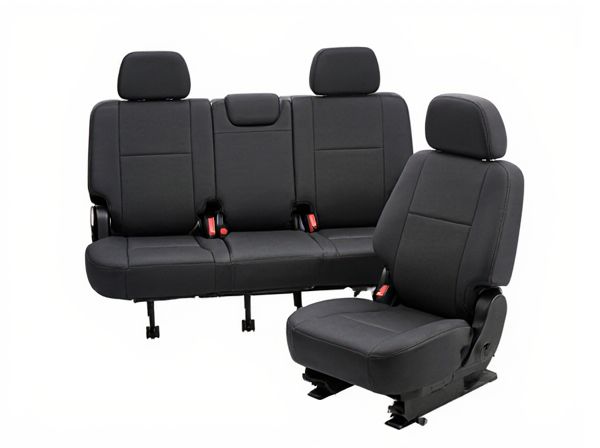
Photo illustration: Bench Seat vs Captain Seat
Bench seats provide a continuous seating surface, maximizing passenger capacity and offering a traditional look ideal for families or group travel. Captain seats deliver individual comfort with armrests and adjustable features, enhancing support and luxury for passengers, making them perfect for long drives or executive vehicles. Your choice depends on whether you prioritize spacious seating or personalized comfort and style.
Table of Comparison
| Feature | Bench Seat | Captain Seat |
|---|---|---|
| Seating Capacity | Typically 3 passengers | Usually 1 passenger per seat |
| Comfort | Less individualized support | Ergonomic, enhanced support |
| Space | Maximizes passenger count | More space per passenger |
| Access | Limited ease to rear seats | Improved aisle access |
| Adjustability | Limited or fixed adjustments | Multiple adjustable features |
| Use Case | Ideal for high passenger load | Best for luxury and comfort |
Introduction to Bench Seats and Captain Seats
Bench seats offer a continuous seating arrangement accommodating three or more passengers, commonly found in traditional pickups and older vehicle models. Captain seats provide individual seating with armrests, enhancing comfort and support, typically featured in SUVs and luxury cars. Both seat types influence vehicle interior space, passenger comfort, and accessibility differently.
Key Differences Between Bench and Captain Seats
Bench seats provide continuous seating space for multiple passengers, typically found in older or more budget-friendly vehicles, while captain seats offer individual, contoured seats with armrests, enhancing comfort and support. Bench seats maximize seating capacity and allow for easier lateral movement, whereas captain seats prioritize passenger comfort and personal space, often featuring adjustable settings. The choice between bench and captain seats significantly impacts vehicle layout, with benches favoring practicality and captains emphasizing luxury and ergonomics.
Comfort and Ergonomics Comparison
Captain seats offer enhanced comfort and ergonomics through individual adjustments, lumbar support, and contoured cushioning designed to reduce fatigue during long drives. Bench seats, while providing more seating capacity, often lack customizable features and may compromise support, leading to less optimal posture and comfort. Ergonomically, captain seats promote better spinal alignment and personalized fit, making them superior for driver and passenger well-being.
Space and Seating Capacity Analysis
Bench seats typically offer seating for three passengers across a continuous cushion, maximizing overall seating capacity, especially in the front row of trucks and SUVs. Captain seats provide individual seating with a center console or gap between them, reducing seating capacity to two passengers but enhancing personal space and comfort. The choice between bench and captain seats impacts vehicle cabin layout, with bench seats prioritizing passenger volume and captain seats emphasizing spaciousness and easier access to rear rows.
Accessibility and Ease of Use
Bench seats provide straightforward access with an uninterrupted, flat surface that accommodates multiple passengers and facilitates easy sliding in and out, ideal for families or group travel. Captain seats offer enhanced accessibility with individual armrests and adjustable controls, enabling personalized comfort and simplified entry and exit for each occupant. The choice between bench and captain seats depends on the balance between maximizing passenger capacity and optimizing ease of movement within the vehicle.
Family-Friendliness and Practicality
Bench seats offer more seating capacity, making them ideal for larger families needing to transport multiple passengers simultaneously. Captain seats provide enhanced individual comfort and easier access to rear rows, which benefits families prioritizing convenience and personal space. Both options improve family-friendliness and practicality, but bench seats maximize passenger volume while captain seats optimize comfort and accessibility.
Safety Considerations for Bench vs Captain Seats
Captain seats offer enhanced safety through individual seat belts and better side support, reducing the risk of injury during sudden stops or collisions. Bench seats, while providing more seating capacity, often lack the contoured design and individual restraints found in captain seats, potentially compromising occupant protection. Modern vehicles increasingly prioritize captain seats in rear rows to meet stringent safety regulations and improve passenger security.
Storage and Interior Flexibility
Bench seats provide continuous seating for three passengers and often include under-seat storage compartments, maximizing usable space in the cabin. Captain seats, typically designed for two passengers, offer more individual adjustments and often come with built-in storage features like armrest compartments and cup holders, enhancing interior organization. The choice between bench and captain seats impacts interior flexibility, with bench seats favoring maximum seating capacity and captain seats prioritizing passenger comfort and accessible storage options.
Popular Vehicles Featuring Each Seat Type
Popular vehicles featuring bench seats include classic pickups like the Ford F-150 and Chevrolet Silverado, known for their spacious front rows accommodating three passengers. Captain seats are prevalent in SUVs and minivans such as the Toyota Highlander and Honda Odyssey, offering enhanced comfort and individual armrests for driver and front passenger. Both seat types cater to different needs, with bench seats prioritizing passenger capacity and captain seats emphasizing personal space and luxury.
Choosing the Right Seat Type for Your Needs
Choosing between a bench seat and a captain seat depends on your vehicle's passenger capacity and comfort preferences. Bench seats maximize seating by accommodating three passengers in a row, ideal for larger families or carpooling, while captain seats provide individual comfort with armrests and more adjustability, suited for longer trips or personal space. Consider how often you transport multiple passengers versus the need for enhanced comfort to select the seat type that best meets your daily driving and lifestyle requirements.
 caratoz.com
caratoz.com